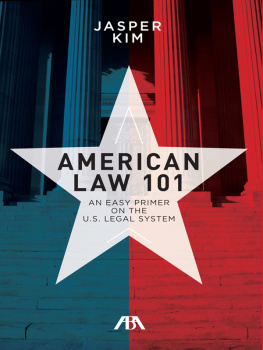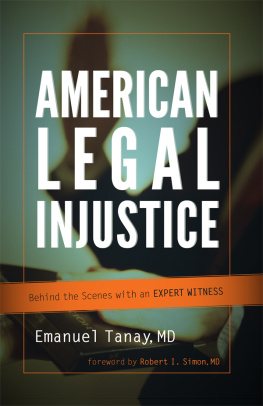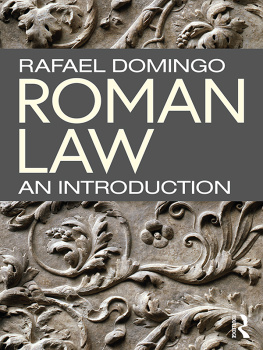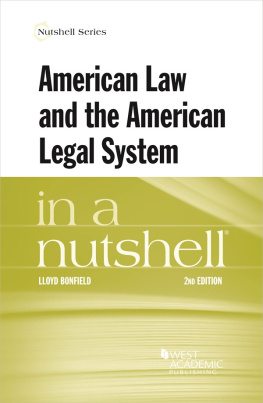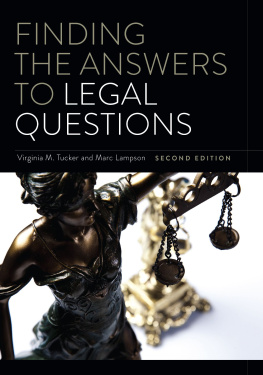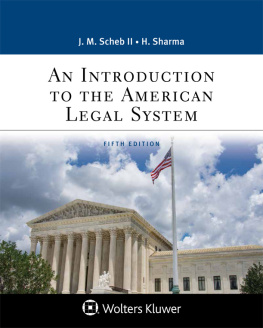JASPER KIM
AMERICAN LAW 101
AN EASY PRIMER ON THE U.S. LEGAL SYSTEM

Cover design by Kelly Book/ABA publishing.
The materials contained herein represent the opinions and views of the authors and/or the editors, and should not be construed to be the views or opinions of the law firms or companies with whom such persons are in partnership with, associated with, or employed by, nor of the American Bar Association unless adopted pursuant to the bylaws of the Association.
Nothing contained in this book is to be considered as the rendering of legal advice for specific cases, and readers are responsible for obtaining such advice from their own legal counsel. This book is intended for educational and informational purposes only.
2015 American Bar Association. All rights reserved.
No part of this publication may be reproduced, stored in a retrieval system, or transmitted in any form or by any means, electronic, mechanical, photocopying, recording, or otherwise, without the prior written permission of the publisher. For permission, contact the ABA Copyrights and Contracts Department by e-mail at .
Library of Congress Cataloging-in-Publication Data
Kim, Jasper, author.
American law 101: an easy primer on the U.S. legal system / by Jasper Kim.
pages cm.
Includes bibliographical references and index.
e-ISBN: 978-1-62722-859-6
1. LawUnited States. 2. JurisprudenceUnited States. 3. Justice, Administration ofUnited States. I. Title. II. Title: American law one hundred one. III. Title: American law one hundred and one.
KF385.K56 2014
349.73dc23
2014041055
Discounts are available for books ordered in bulk. Special consideration is given to state bars, CLE programs, and other bar-related organizations. Inquire at Book Publishing, ABA Publishing, American Bar Association, 321 North Clark Street, Chicago, Illinois 60654-7598.
www.ShopABA.org
This book is dedicated to my family, my friends, and the countless people who shaped and influenced my life.
TABLE OF CONTENTS
INTRODUCTION
American Law 101: An Easy Primer on the U.S. Legal System is a simple and reader-friendly primer on American law principles geared for a wide audience of both lawyers and non-lawyers worldwide.
American Law 101 covers both the spirit and black letter law principles underlying the American legal system. In terms of readership, American Law 101 is geared towards an extremely broad spectrum, including American and foreign lawyers, business professionals, law and business students, and administrators, as well as the simply curious. American Law 101 reaches its broad audience in part by using plain English in simple, reader-friendly, and understandable language. At the same time, while American Law 101 provides some of the core principles underlying the American legal system in a straightforward way, its scope and mandate may not allow for each possible exception to be fully covered.
American Law 101s substance and style include the following:
- An easy-to-read and succinct primer on some of the core law concepts covered in many American law schools
- A comprehensive, quick, and easy-to-understand American law primer geared for a very broad audiencelawyers, non-lawyers, students, and administrators, domestically and internationally, in the legal profession and marketplaceas an introduction, summary, or review of important American law principles
- Concepts and terms explained simply using plain English with minimal use of jargon, legalese, American colloquialisms, cultural and sports references, slang, and other related references
- Short executive summary sections accompanying each chapter as useful wrap-ups
- Simple diagrams and explanations conveying concepts clearly and concisely
As with all written works, American Law 101 has been helped by other publications related to and preceding it. The Unofficial Guide to Legal Studies in the U.S. for Foreign Lawyers (ABA 2012) is a very well-produced ABA publication focusing on the American law school experience, separate from covering core American law concepts. Law 101: Everything You Need to Know About American Law (OUP 2010) is another useful book that covers American law concepts and topics at a minute, detailed, and technical level, which could be appropriate for a semester-long course. American Law and Legal Systems (Pearson 2011) is another full and formal academic text rather than a quick and easy primer on American law. In terms of writing like an American lawyer, Plain English for Lawyers (Carolina Academic Press 2005) is an excellent resource. Finally, How Law Students Should Think (Amazon Digital Services, Inc. 2011) is an insightful, complementary resource for those who want to understand how to succeed in the potentially competitive environment of some American law schools. Readers interested in learning more in depth and formally about American legal concepts, or the American law school experience, should certainly refer to some or all of the above publications, which are complementary but distinguishable from this book.
I am grateful for the opportunity afforded to me by the ABA to write American Law 101 . Any one book attempting to encapsulate a field as intricate, influential, and dynamic as the American legal system has a daunting mandate. This book therefore should represent the beginning, not the end, of the readers roadmap to American law.
Moreover, any mistakes in this book are my own.
As you read this books pages, I hope that American Law 101 sheds at least a small light on your road towards a better understanding of the American legal systemand the legal professionals working in itdomestically and internationally.
HOW TO THINK LIKE AN AMERICAN LAWYER
How do American (U.S.-licensed) lawyers think? What is the objective of American law schools? The two questions are interrelated. American law school education aspires to teach students how to think like a lawyer. For many students, this mandate is murky. Many of them arrive at law school with the assumption that the objective of a U.S. law school is to teach the law. But is it?
The short answer is yes and no. Yes, American law schools do teach the law, but the instruction of the law is often equally valued with how to use the law. To use the law, a future American lawyer must know not only what the law is, but also how to use and apply the law. Put simply, the difference is similar to the difference in understanding and memorizing the rules of a game versus knowing the process and strategy of how to play the game.
As a modern 21st century analogy of explaining the thinking process and how it relates to the American legal system, think of the American legal systemincluding the law itself within this legal systemas the systems hardware. The ability and skill set to process and effectively leverage this system in a value-added way is thinking like a lawyer, which represents the American lawyers software.
So how do American lawyers think? American lawyers think through a structured analytical approach that allows them to filter vast types of relevant and irrelevant information and data to ultimately arrive at a recommended course of action vis--vis this structured analysis.
The IRAC approach reflects one, but not all, of the main ways that American lawyers think. The IRAC legal method is described as follows:
- I ssue: Legal question is presented.
- R ule (of law): Rule of law that applies to the Issue is determined.
- A pply: Rule (of law) is applied to the cases specific facts.

